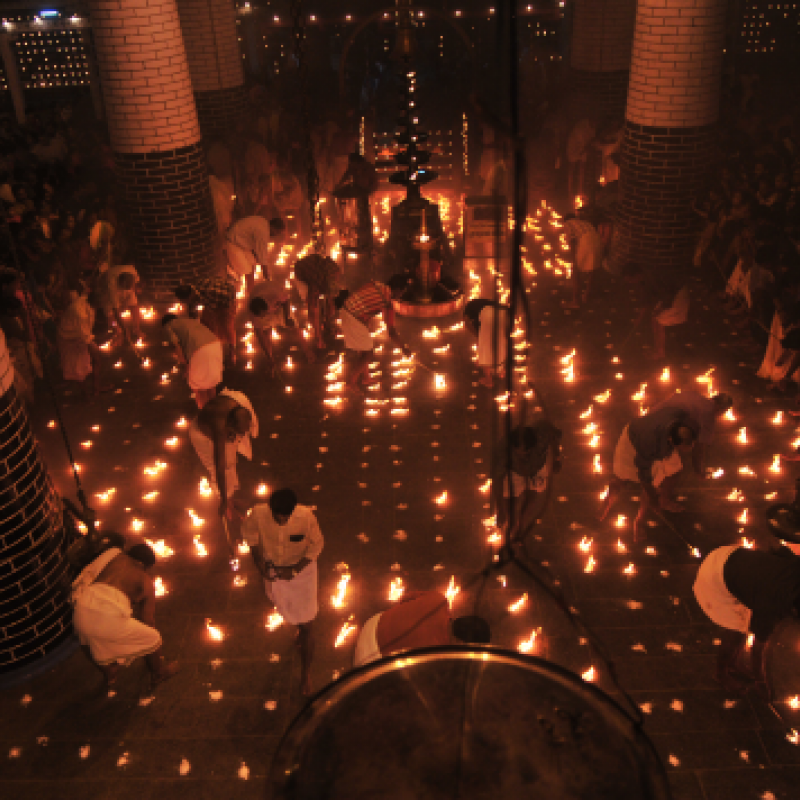It is believed that the history of Kochi royalty starts at Thiruvanchikkulam near Kodungallur during the reign of Cheraman Perumal. The legend up to their arrival in Thripunithura by the late eighteenth century goes as follows. In 1102 CE, before Cheraman Perumal (the last perumal of the second Chera dynasty) left on a pilgrimage, he partitioned his kingdom among his sons and nephews. One of his sisters was married to Perumpadappu Namboothiri and her son, Veera Kerala Varma, is considered to be the first known king of Kochi. Members of various branches of the family stayed in numerous places including Perumpadappu in Vanneri, nearby Koippally, Pazhayannur and Vellarappalli near Aluva, before settling down in Thripunithura.
The legend of the origins of the Poornathrayeesa temple in Thripunithura, which came to be known as the deity of the Kochi kingdom, starts with the lack of progeny in the family; there are stories and even the occasional proof[1] regarding the frequent adoptions the family had to carry out. The deity of the Poornathrayeesa temple is Santhanagopalamurthi, the particular form of Mahavishnu who provides the devotee with progeny. It is believed that there were no more adoptions in the family after they started worshipping this particular deity.
Apart from Poornathrayeesa, the family has had different deities, peculiar to the places of their residence throughout the transition mentioned above. Such family deities were called paradevatha. Accordingly, the deities of Thiruvanchikkulam temple, Koippally temple and Pazhayannur temple also became their family deities.
With time, Poornathrayeesa became the major paradevatha of the family though in the family temples of different palaces Pazhayannur Bhagavathy (the goddess) is worshipped along with Poornathrayeesa. All the functions and other events in the family have rituals associated with the temple of Thripunithura. The construction of the modern building of the temple was finished in the late nineteenth century.
Given below is the list of the festivals of the temple and how they are celebrated by the members of the royal family and the local people of Thripunithura, elaborating on three major festivals and their mythical and ritualistic details.
Moosari Utsavam is one of the most important festivals of the temple as it is related to consecration of the deity. Legends says that one day the idol of the lord caught fire and was damaged. The temple was shut down and in a devaprashnam (an astrological ritual to decipher the attitude of the deity) it was prescribed that the idol ought to be reconstructed with panchaloha.[2] The Moosari community (bronze smiths) were approached by the king and temple authorities for this sacred work. There were very few people who had seen the image of deity and fewer responded to this call. After several days, a Moosari who was an ardent devotee of the deity accepted the task of constructing the idol. The work began in the month of Chingam in the Malayalam calendar (August–September). The Moosari tried hard to create the perfect image in the mould several times, without success. After many attempts, the king proclaimed that the smith would be given the death sentence as punishment for his failure. The legend goes on to suggest that in his final attempt the Moosari subsumed himself into the mould cast with the molten metal, as per the god’s command, and through this ultimate sacrifice produced the perfect idol. The idol was consecrated with all rituals and pomp and, to commemorate this great devotee, a festival was held. Hence, the annual festival called Moosari Utsavam is held in the month of Chingam for eight days to honour the Moosari.(Fig.1) This festival is held on a very low profile, with the festivities restricted to a kotiyettu (flag hoisting) and an aarattu (idol immersion marking the end of the festivities). As part of this festival, Nangyar Koothu[3]is conducted inside the temple. The aarattu falls on the final day of the Onam festival.

Thulam Ninth Festival is conducted to commemorate the return of the idols to the temple after a major fire occurred in the temple in 1920. The major programme of the day involves bringing camphor from the nearby Canara Bank (previously the Poornathrayeesa Bank) on a decorated elephant with panchari melam[4] to the temple premises. This camphor is to be lighted during the regular evening ritual called deeparadhana in the temple.(Fig.2)
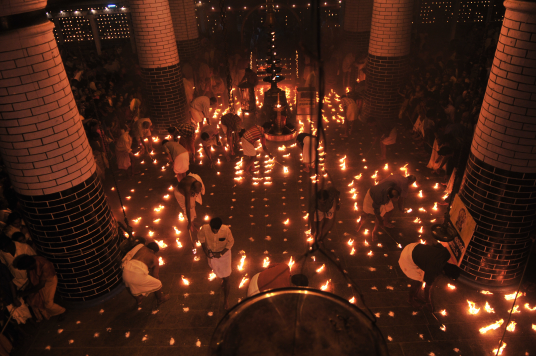
Vrischikotsavam is the annual festival of Poornathrayeesa temple, conducted in the month of Vrischikam (November–December) for eight days. On all days, fifteen elephants are stationed at the temple and a procession with them takes place inside the temple complex with panchari melam twice a day. The members of the Kochi royal family, erstwhile patrons of the festival, occupy the Thattumaalika[5] or the balcony overlooking the southern courtyard of the temple.(Fig.3)
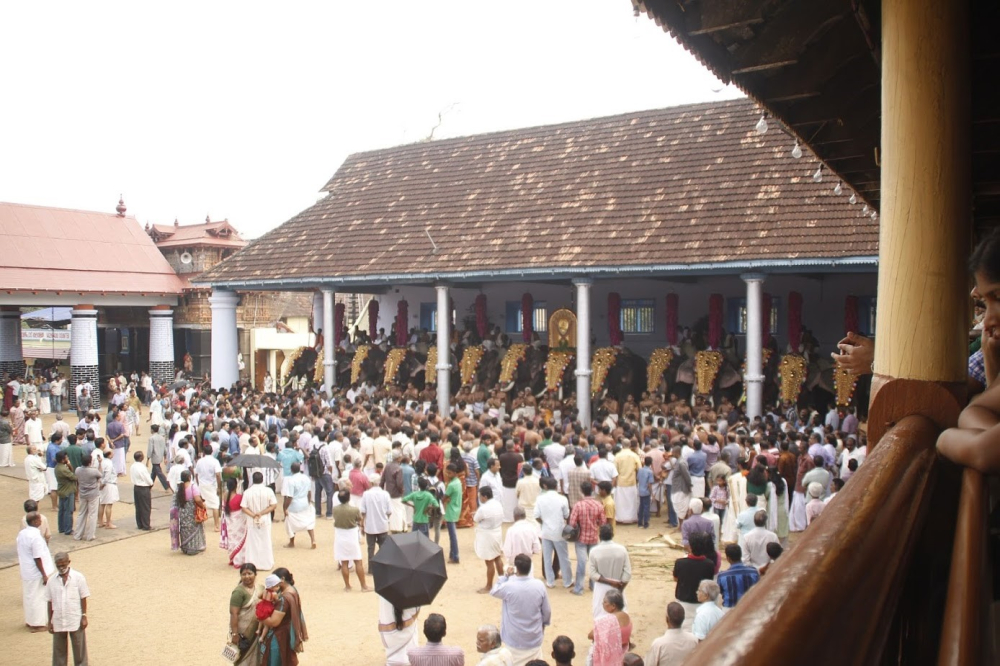
Various art performances and rituals take place in the temple during these eight days of the festival including thayambaka[6], musical concerts and Kathakali. (Fig. 4)
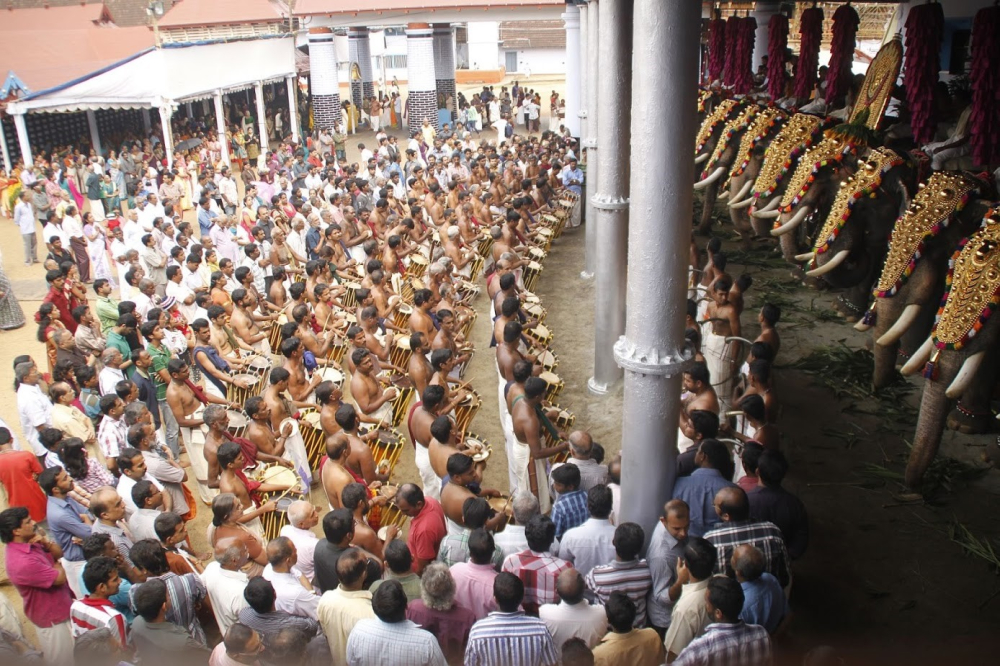
On the fourth day of the festival, which falls on the star of Thrikketta, there is a unique procession at night, which is known as Thrikketta Purappadu. The idol is bathed in a ritual, called thiruvanjanam, using different materials considered auspicious, including panchagavyam (prepared from five elements received from a cow such as milk, urine, cow dung, buttermilk and ghee in particular proportions) and water. In the evening after deeparadhana the idol is placed on a decorated elephant for procession, with golden kolam enriched with precious stones. The umbrella used on the occasion is also made of gold. Police personnel perform the guard of honour at the beginning of the procession.
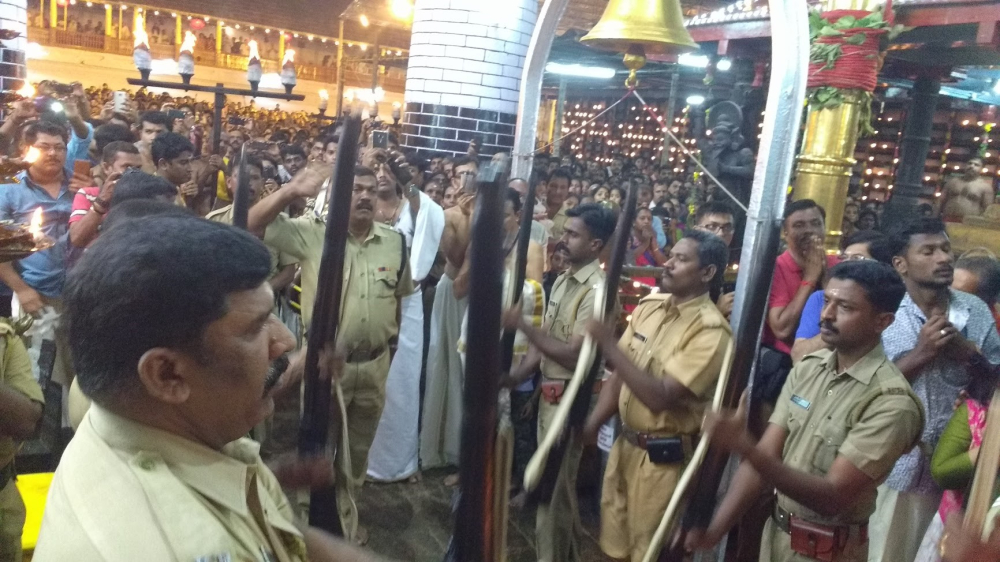
Another important ritual of the day is offering kanikka (money) to the deity at the aanakkottil (shed for elephants). The first kanikka is offered by the eldest member of the family, followed by other family members and the public.
On the seventh day of the festival, known as valiavilkku (large lights), all members of the royal family go to the temple to offer the mandatory offering called atima-puthan (literally meaning the slave-money) symbolically renewing their slave-status vis-à-vis the deity, the Poornathrayeesa. Valiavilakku as the name suggests is a grand procession that starts from seven in the evening, lasting for about five to six hours.
On the eighth day of the festival, the aarattu (the religious bathing ceremony of the idol) is carried out. The procession for aarattu takes a detour through the western gopuram of the temple to visit the family of Elayidath Moothathu to whom the temple belonged according to legend. This is a unique feature of the Vrischikam festival as on all other occasions the idol is carried through the eastern gopuram. The procession starts with panchavadyam[7] under the banyan tree. The aarattu takes place in the temple tank of the Siva temple at Chakkankulangara about a kilometre north-east from the temple.
Uthram Vilakku: On the day of the star Uthram in the month of Kumbham (February–March), there is a day-long festival in the temple to commemorate the installation of the idol. On this day, members of the royal family offer atima-puthan to the deity along with appam (a sweet dish made with rice and coconut) fried in ghee.
Para Utsavam: This festival also takes place in the month of Kumbham. Here, it is believed that the deity goes out of the temple to his estate to take stock of the situation. The idol is placed on an ornate elephant and paraded across the town in a cardinal direction. The elephant visits the houses of the devotees of the deity and receives offerings made by them in the form of grains, rice flakes, jaggery and banana in a para (a large measuring vessel once used to measure grains and other agricultural produce). Hence, this festival is called the Para Utsavam. (Figs. 6 and 7) In recent times the deity does not visit individual houses, but rather stops at specific points where devotees gather around and offer the materials.
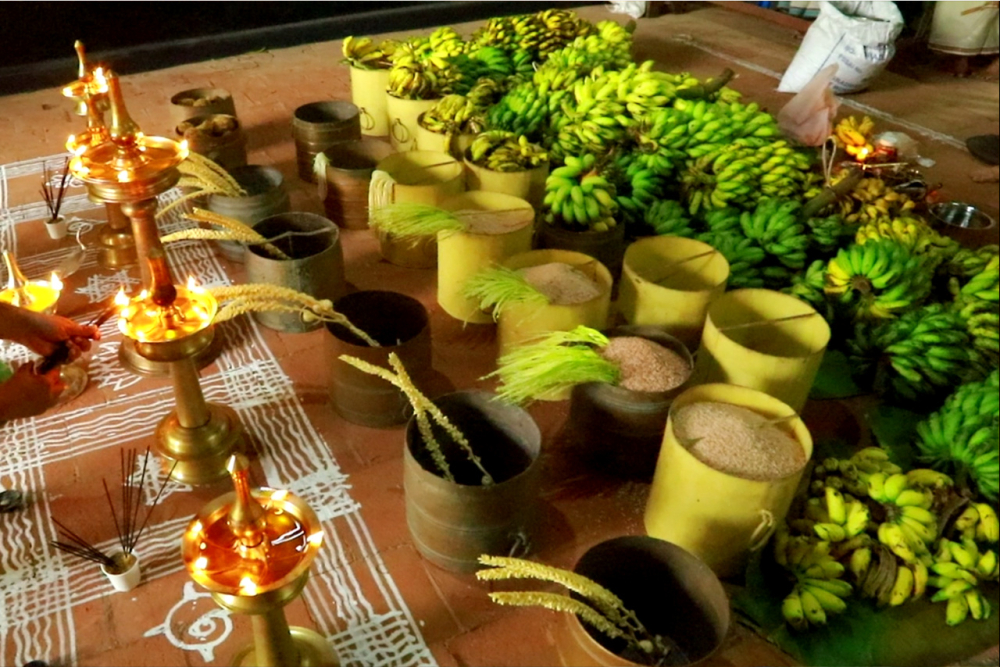
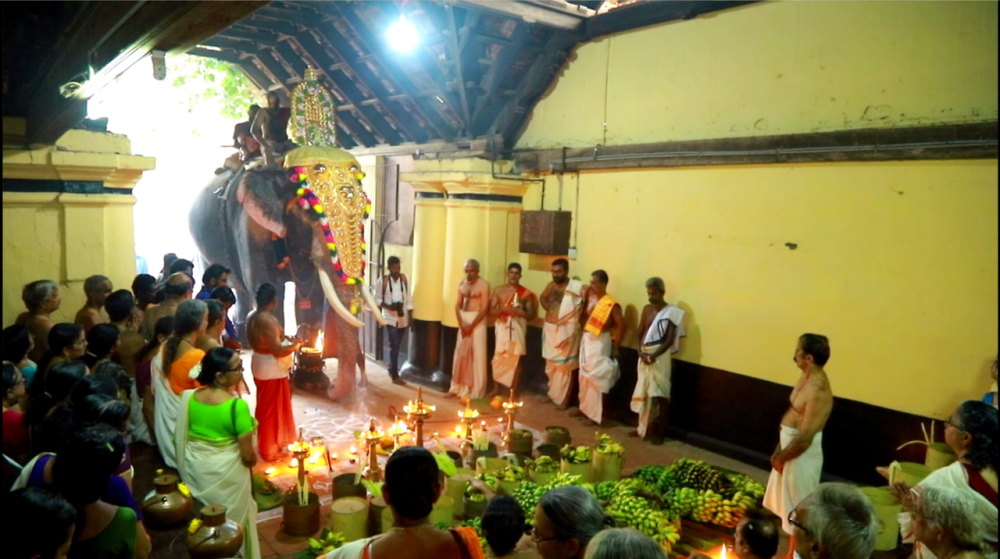
After this parade, the idol is taken back in a boat across River Poorna (Fig. 10) and an authorised person sits by the deity and symbolically informs and updates him (Poornathrayeesa) about all the collections of previous years.
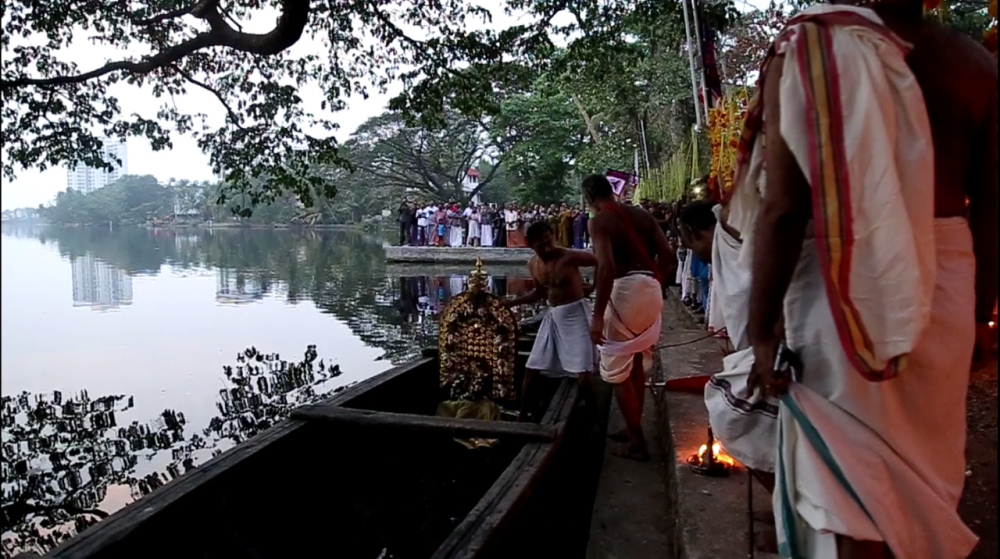
A person from the temple authority also places an ezhuthani (sharpened iron rod once used to write on palm leaves) and a chisel. In return Moothathu, representing Poornathrayeesa, gives him pudava (cloth) in appreciation of his work. Then the idol is taken to Poonithura which is considered to be the Moolasthanam (original place) of the deity, before being taken to the other places.
On the sixth day of Para Utsavam the deity visits Vadakkedathu Mana, the birthplace of his consort Nangema, according to another legend. The legend goes that a girl named Nangema from the Mana used to visit Poornathrayeesa temple every day and she was an ardent devotee of the deity. When her marriage was fixed with someone far away from Thripunithura she was distressed that she would not be able to see her god every day. One day before her wedding she went to the temple and never came back. It is believed that she merged with the deity and became one with it forever. Hence, when Poornathrayeesa visits the Mana every year during Para Utsavam, he is welcomed and treated as the son-in-law of the family, visiting the house of the girl. He gives clothes as presents to the members of the family. Alternately, Para Utsavam is sometimes termed Nangema Utsavam.
Notes
[1] There are mentions in the Dutch archives about some of the ceremonies and rituals associated with the adoption of such heirs.
[2] Gold (Au), silver (Ag), copper (Cu), zinc (Zn) and iron (Fe) are the major constituents of panchaloha, which is the combination of these five metals. In some cases tin (Sn) or lead (Pb) is used instead of zinc.
[3] Nangiyar Koothu is an art form associated with Kootiyattam, which is an age-old Sanskrit theatre form of India. Nangiyar Koothu is the sole domain of women performers who in the old days were called Nangiyaramma and belonged to the Ambalavasi communities. Stories are narrated in this performance using hand gestures, facial expressions and body movements, accompanied by a percussion instrument called mizhavu.
[4] Panchari melam is one of the traditional percussion ensembles performed during temple festivals in Kerala. The basic instrument used in panchari is chenda, and other instruments are kombu, kuzhal and ilathalam. It is performed in different parts of Kerala with regional variations.
[5] Thaattumalika is a unique structure constructed outside the compound wall of the Poornathrayeesa temple, but along the periphery of the temple on the southern and south-western part of the temple.
[6] Thayambaka is a solo chenda performance of Kerala, in which the main player at the centre improvises rhythmically with the beats of half a dozen or more chenda and ilathalam players around. It is primarily a temple art, also performed outside of temples in open fields or stages.
[7] Panchavadyam is an orchestra of five instruments, as the name suggests, and is performed in temples as part of festivals. These five instruments are timila, maddalam, ilathalam and idakka, which are percussion instruments, and kombu, which is a wind instrument.
